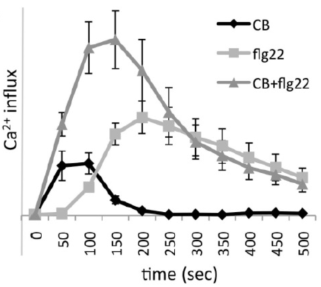Plant and animal hosts are thought to “identify” and respond defensively to two signals generated during pathogen attack – one is a MAMP or conserved microbe molecular (such as bacterial flagellin or fungal chitin) and the second a “pattern of pathogenesis” (such as microbe effectors injected into host cells; host cell wall damage due to microbe hydrolytic enzymes). One signal is insufficient to distinguish pathogens from commensals. C. Souza has demonstrated that cellulose fragments act as a “pattern of pathogenesis” to elicit defense responses. Furthermore, combined treatments of cellulose fragments and flagellin elicit synergistic defense responses.
| Plant & Microbial Biology | College of Natural Resources | University of California, Berkeley | ©Shauna Somerville Lab |

